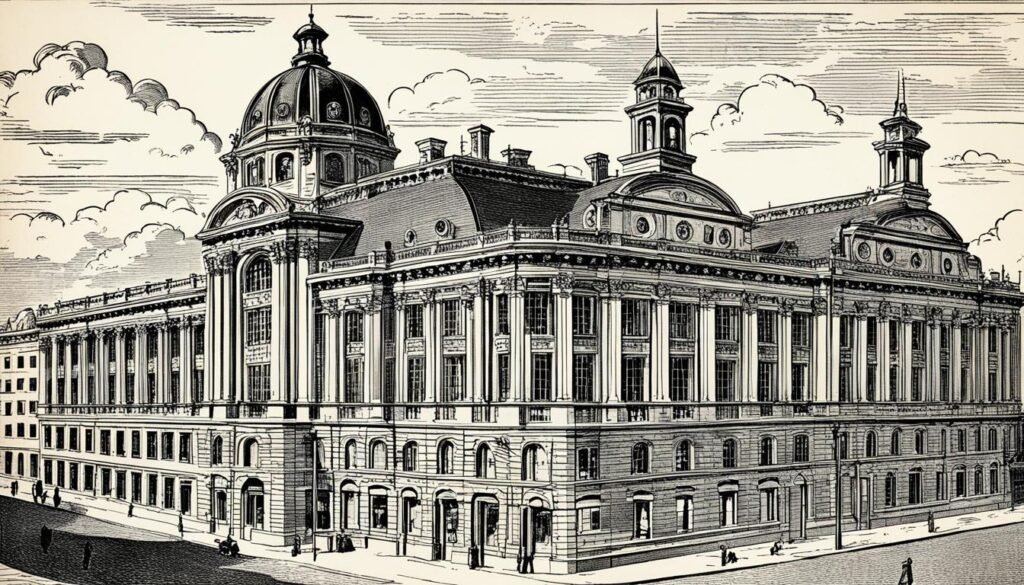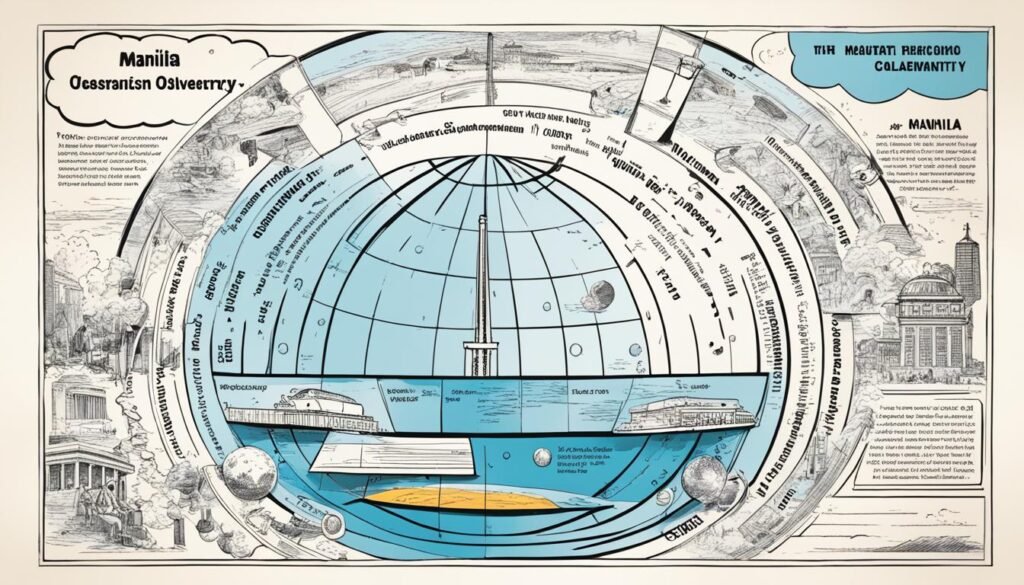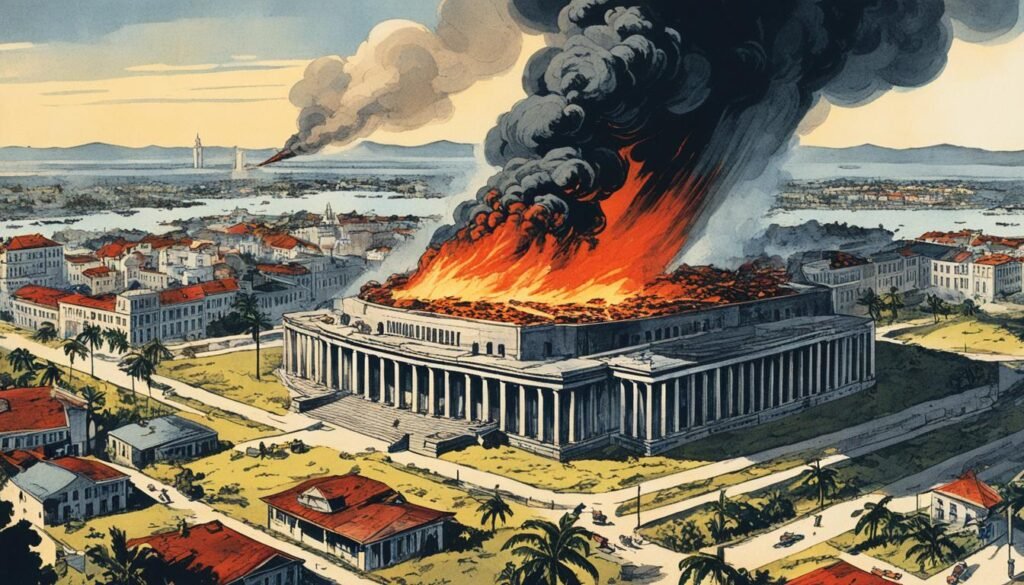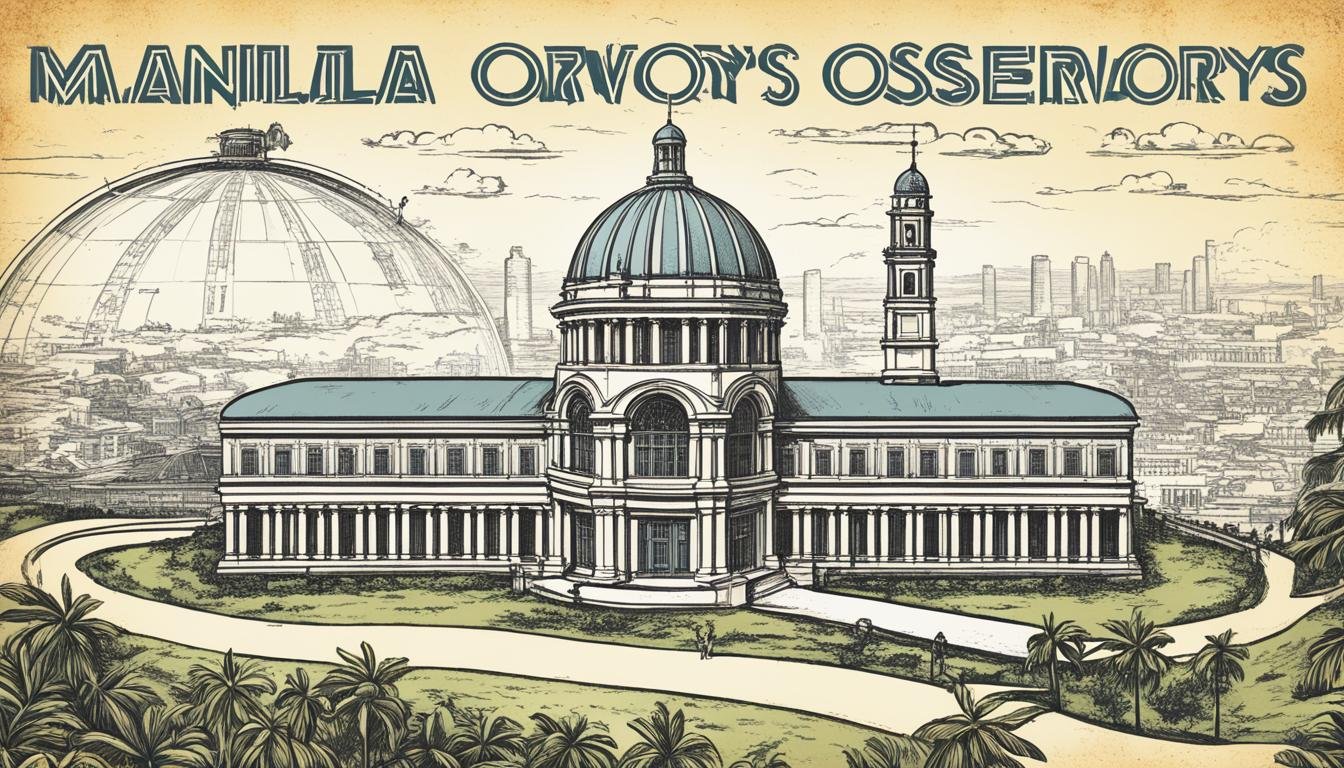The Manila Observatory was established in 1865. It stands as one of the oldest research institutions in the Philippines. It began with the Jesuit mission and has since grown from basic weather work to a leading center for meteorology, seismology, and astronomy.
Typhoon warnings started in 1879 and earthquake observations began in 1880. The Spanish government recognized the Observatory in 1884 for its weather forecasting. This showed its increasing importance.
By expanding into time service, seismology, and astronomy, the Manila Observatory grew. But during World War II, it faced heavy losses. The Observatory and its work were destroyed in the Battle of Manila.
After the war, the Manila Observatory resumed its work. It first reopened in Baguio and then moved to the Loyola Heights campus of the Ateneo de Manila University. Here, it carries out studies in seismology, geomagnetism, and more.
Key Takeaways
- The Manila Observatory was established in 1865 by the Jesuit mission in the Philippines.
- The observatory began issuing typhoon warnings in 1879 and initiated earthquake observations in 1880.
- In 1884, the Spanish government recognized the Manila Observatory as the official institution for weather forecasting in the Philippines.
- The observatory expanded into various scientific fields, including time service, seismology, and astronomy over the years.
- The institution suffered devastating damage during World War II, but resumed operations in the post-war era, relocating to the Loyola Heights campus of the Ateneo de Manila University.
Introduction
The Manila Observatory is a key scientific hub in the Philippines. It was founded back in 1865, making it over a hundred years old. The Jesuit mission started it, and it focused on activities like watching the weather, looking at earthquakes, and studying earth movements.
Through the years, the place has changed a lot, keeping up with new science. Now, the Manila Observatory helps out in many ways. It tackles issues that matter a lot, both here and worldwide. This includes things like the environment and how we develop different places. So, the Observatory’s work is important, not just for science but for the planet too.
Significance of the Manila Observatory
The Manila Observatory stands tall as a top research center in the Philippines. It has greatly helped in many areas of science, like predicting the weather, understanding earthquakes, and the earth’s movements. All this science isn’t just in books. It helps make real decisions about our planet and its future.
Overview of the Observatory’s Historical Journey
For more than a hundred years, the Manila Observatory has been a key player. It has seen many changes and improvements, always looking forward. Started by the Jesuit mission long ago, it’s now a big part of science and bettering the environment in the Philippines.
Founding Stage: Observatorio del Ateneo Municipal (1865-1884)
The Manila Observatory, or the Observatorio del Ateneo Municipal, started in 1865. It was supported by the Jesuit mission in the Philippines. Teachers and students from the Ateneo de Manila University worked on checking the weather and released the data.
Establishment under the Jesuit Mission
A Jesuit priest named Father Jaime Nonell wrote a piece in Diario de Manila. It talked about the weather work done by another Jesuit, Father Francisco Colina. This led people to want more weather reports. The Jesuits and Ateneo de Manila stepped up to meet this demand during the Observatory’s beginnings.
Early Beginnings in Weather Observation
From the start, the Observatorio del Ateneo Municipal focused on keeping regular weather observations and warning about typhoons. This work kicked off in 1879. The Ateneo’s professors and students managed these tasks, creating a solid base for the Manila Observatory’s future success.
Second Stage: Observatorio Meteorológico de Manila (1884-1899)
The second stage of the Manila Observatory’s journey was from 1884 to 1899. In this period, the Observatorio Meteorológico de Manila became the official weather forecasting group in the Philippines. The Spanish government made it official by royal decree. This decree led to the creation of the Servicio Meteorológico, the Meteorological Service, under the observatory’s guidance.
Recognition as the Official Weather Forecasting Institution
During this time, the Observatorio Meteorológico de Manila grew its work and services. It added parts focusing on meteorological, magnetic, and seismic activities. The Observatory started providing accurate time, which was especially helpful for ships at sea. Also, in 1887 it started a seismology section. By the end of this phase, the Observatorio Meteorológico de Manila was known around the world. It was praised for its spot-on typhoon predictions and its scientific work.
Expansion into Meteorological, Magnetic, and Seismic Sections
At this time, the Observatorio Meteorológico de Manila was getting its funds from the government. It did this through three key areas: meteorological, magnetic, and seismic activities. The Observatory had help too. Fourteen stations in Luzon were helping out. They were run by people from the Telegraphic Service. They sent in daily weather observations.
Third Stage: Oficina Meteorológica (1899-1945)
The third era of the Manila Observatory, called the Oficina Meteorológica or Weather Bureau, ran from 1899 to 1945. In 1901, the Meteorological Service got a reorganization. It became the Oficina Meteorológica or Weather Bureau. This new setup included a Director, 3 Subdirectors, and one subaltern. They were in charge of four Departments.
The Weather Bureau’s role expanded. It started handling meteorology, astronomy, and geomagnetism. Also, it set up and managed over 50 secondary stations across the Philippines.
Reorganization under American Colonial Rule
In 1901, the Manila Observatory shifted focus under the American colonial rule. It was then known as the Philippine Weather Bureau. But, by the time World War II started, the Observatory faced a huge setback. This was because its valuable tools and documents were destroyed in the Battle of Manila, notes Fr. Miguel Selga.
Diverse Departments and Secondary Stations
The Weather Bureau had control over a network of 50 secondary stations. Notably, it showed a strong growth in its reach. This growth wasn’t just in meteorology. It also handled some astronomy and geomagnetism activities. The Bureau kept on serving the Philippines during the American colonial era.

The Manila Observatory’s Destruction during World War II
The Manila Observatory faced a severe hit during World War II. Everything, from its precious instruments to its scientific papers, was lost in the Battle of Manila. This event ended the third stage of the Observatory and stopped its scientific work for years.
Father Miguel Selga, the third director, wrote about the Observatory’s tragic end in the Iberica magazine. He described the destruction and war damage that nearly destroyed the Observatory. This damage could have stopped its important work for the scientific community.
But the Manila Observatory wasn’t defeated. It chose to rebuild and start fresh after the war. In the years that followed, it stepped back into the spotlight. Once again, it became a leading scientific body in the Philippines and the Asia-Pacific area.
Fourth Stage: Post-War Restoration (1945-Present)
In 1945, the Manila Observatory faced the task of rebuilding after the war. Father Charles Deppermann played a key role in this effort. With help from colleagues like Fathers Bernard Doucette and James Hennessey, they started by setting the Observatory up in Baguio. There, they focused on observing the ionosphere, earthquakes, the sun, and magnetic fields.
Rebuilding Efforts by Father Charles Deppermann
The Manila Observatory moved to the Loyola Heights campus later. Thanks to Deppermann and others, the research work expanded. They added new team members like Fathers Richard Miller, Francisco Glover, Sergio Su, and Father Victor Badillo. In 1966, Badillo became the leading figure of the Ionosphere Research group. He was the only Jesuit priest with a Ph.D. in the group.
New Orientation and Scientific Advancements
After the war, the Manila Observatory took on a new focus. It started using the latest scientific knowledge to address global issues. Father Badillo became the Director in 1972. He held this role for almost twenty years. During his time, he played a major part in supporting the Philippine Astronomical Society (PAS).
Expansion into Ionospheric, Seismic, Solar, and Magnetic Observations
The Observatory’s work in ionospheric, seismological, solar physics, and geomagnetism increased over time. This was all thanks to its dedicated scientists. For example, Dr. Quirino Sugon Jr. represented the Observatory at the 1st Workshop of the International Space Weather Initiative (ISWI) in Egypt in 2010. He shared plans about setting up a server for six Philippine magnetometers. This server would allow real-time study of the Philippine magnetic field.

The Manila Observatory’s Location
The Manila Observatory is now at the Ateneo de Manila University in Quezon City, Philippines. It was first in Intramuros, Manila. Later, it moved to Baguio after the war. In 1963, it found its permanent home in Loyola Heights.
In Quezon City, near Metro Manila, the Manila Observatory is near the Ateneo de Manila University. This area is known for the university and helps the Observatory work closely with it. This collaboration helps in advancing research.
It’s located at 14°38′12″N 121°04′36″E, in the Loyola Heights campus. Here, it conducts various research work. This includes studies on climate change, earth dynamics, and air quality. The place is perfect for the Observatory’s important work.
Organizational Structure and Research Programs
The Manila Observatory has two main parts: administration and research. The admin side handles things like accounting, HR, and facilities. The research programs work on areas like helping with climate change, geomatics, and more.
The Observatory recently put a lot of effort into climate change adaptation and disaster risk management. It also looks into the benefits of climate change mitigation. This shows their strong focus on important environmental and development concerns.
Administrative and Research Units
In Manila Observatory, admin and research support each other. Administration makes sure the place runs smoothly day to day. The research side is behind the exciting work in meteorology and more.
Climate Change Assistance and Environmental Research
The Observatory lately focuses on helping with climate change and doing environmental research. Their work now covers big world issues like climate change’s effects and disaster management. They work with many to tackle these problems.
The Manila Observatory’s Contributions
The Manila Observatory has played a big role in many scientific fields. It’s well known for its precise typhoon forecasting and early meteorological studies. These helped the Philippines and the wider area. Besides, the Observatory’s work in seismological and geomagnetic research has also been key. These efforts better our knowledge of the Earth’s changes and warn us about the dangers of natural disasters. Not only do these achievements further science, but they help make decisions in disaster management and adapting to climate change.
Accurate Typhoon Forecasts and Meteorological Studies
In the field of typhoon forecasting and meteorological research, the Manila Observatory shines. For years, it’s been providing accurate, early alerts about typhoons. This has lessened the impact of these storms on the Philippines and nearby areas. Its studies in the science of the atmosphere, climate change, and weather have improved our insight into the complex weather patterns of the area.
Seismological and Geomagnetic Research
Besides its work in meteorology, the Manila Observatory has done important work in seismological and geomagnetic research. It tracks and studies earthquakes and the Earth’s magnetic field. This has helped us understand more about our planet’s forces. The research is used to create early warning and risk reduction plans, which protect people and property during natural disasters.

Notable Personnel and Directors
The Manila Observatory’s story is deeply connected to key people like Father Federico Faura. He was a Jesuit priest who not only founded it but was also the first director. His work at the beginning was crucial, helping the institution get off the ground. He gave it direction and purpose. Father José Murgadas and Father Miguel Selga also made significant contributions. Murgadas supported the Observatory’s growth in research areas like meteorology and seismology. Selga, on the other hand, documented the tragic events of World War II, including the Observatory’s damage. The Manila Observatory has always had a strong team of Jesuit scientists and administrators behind it. Their dedication has been key to its long success.
Father Federico Faura: The Founder
Father Federico Faura was a Jesuit priest with a vision. In 1865, he founded the Manila Observatory and became its first director. His leadership was essential in defining the Observatory’s early focus on studying weather and other scientific research. Through Faura’s hard work and vision, the Observatory started its journey to becoming a respected scientific hub in the Philippines.
Other Influential Figures and Scientists
Many other influential Jesuit scientists and administrators have left their mark on the Manila Observatory. Father José Murgadas, for example, was the subdirector during a period of growth for the Observatory. He helped expand its research fields to include meteorology, magnetism, and seismology. Father Miguel Selga had a vital role in keeping the Observatory’s history during World War II. Even in difficult times, these and other notable personnel ensured the Manila Observatory kept progressing and overcoming challenges.
Challenges and Milestones
The Manila Observatory faced big challenges, especially during World War II. It suffered from wartime destruction, losing all its instruments and documents during the Battle of Manila. This loss could have stopped its work. But, thanks to the courage and hard work of its leaders, like Father Charles Deppermann, the Observatory was rebuilt. It resumed its work, keeping its mission alive.
The Observatory always kept up with the latest in science and technology. It constantly improved its research programs to lead in scientific discovery. Even faced with these difficulties, it reached important achievements. These successes made it stand out in the Philippines and Asia-Pacific region as a top scientific place.
Overcoming Wartime Destruction
The Second World War brought terrible damage to the Manila Observatory. It lost all its important tools. This was a hard blow, pausing its work for years. Yet, thanks to the hard work of leaders like Father Charles Deppermann, the Observatory was restored after the war.
Adapting to Scientific Advancements
Over time, the Manila Observatory showed it could keep up with new science. As new technologies and research methodologies emerged, it changed and improved its programs. This ability to adapt has been vital. It helped the Observatory go past challenges and achieve major successes. It proved to be a top place for science in the region.

The Manila Observatory’s Legacy
The Manila Observatory stands out for its strong commitment to scientific research. For more than a hundred years, it’s been a key player in studying the weather, earthquakes, and the earth itself. This work has deepened our knowledge of the natural world and how we affect it.
Enduring Commitment to Scientific Research
Over the years, the Manila Observatory has taken on big global challenges like climate change, disaster risks, and development. It works closely with policymakers and others to make our world safer and more sustainable. The legacy of science it leaves inspires young researchers to keep pursuing excellence and innovation.
Role in Environmental and Development Concerns
The Manila Observatory leads in environmental research and development concerns. Its wide range of studies offer crucial information, helping leaders make better choices and fight world challenges. Through collaboration and knowledge-sharing, it boosts its global influence and earns its top spot as a scientific authority in the area.
Conclusion
The Manila Observatory is a symbol of lasting scientific legacy and thirst for knowledge. It was started in 1865 by Jesuit priests. It has since become a world leader in studying weather, earthquakes, and earth movements. This commitment to research helps with important environmental and development concerns in the Philippines and the whole Asia-Pacific region.
Despite facing many challenges, like being destroyed in World War II, the Observatory stayed strong. It rebuilt itself to keep being a leader in science. As it keeps growing, the Manila Observatory’s influence on science and environmental stewardship will continue. It will motivate future scientists to follow its path of excellence and service.
The Manila Observatory shows the power of science and solving big problems the world faces today. By pushing the limits of what we know, this institution helps create a better, more sustainable future for everyone.
FAQ
What is the Manila Observatory?
The Manila Observatory is a private scientific research group set up in 1865. The Jesuit mission in the Philippines founded it. It is known for its work in meteorology, seismology, and geophysics.
When was the Manila Observatory founded?
The Manila Observatory started its work in 1865. It was started by the Jesuits. They first called it the Observatorio del Ateneo Municipal.
What were the early focus areas of the Manila Observatory?
At first, the Manila Observatory mainly watched the weather. They also started to warn people about typhoons in 1879.
When was the Manila Observatory recognized as the official weather forecasting organization in the Philippines?
In 1884, the Spanish government made a formal announcement. It said the Manila Observatory was in charge of predicting the weather in the Philippines.
How did the Manila Observatory expand its research and service capabilities?
Between 1884 and 1899, the Observatory grew and offered more services. They added work in meteorology, magnetic, and seismic studies. They also helped with time for shipping and started a section on seismology.
What happened to the Manila Observatory during World War II?
World War II caused huge damage to the Observatory. The battle in Manila destroyed it. All its equipment and papers were lost.
How was the Manila Observatory rebuilt after World War II?
After the war, Father Charles Deppermann led the rebuilding. He and his team set up the Observatory in Baguio. They focused on studying the ionosphere, seismic activity, the sun, and magnetic fields.
Where is the Manila Observatory currently located?
Today, the Manila Observatory is on the Ateneo de Manila University campus. It’s in Quezon City, Philippines.
What are the main research programs of the Manila Observatory?
The Observatory researches many topics. These include helping with climate change, geomatics for the environment, and new technologies. They also work on studying climate, earth movements, air quality, and do special research projects.
What are some of the notable contributions of the Manila Observatory?
The Manila Observatory is known for its accurate typhoon warnings. It has also made new discoveries in meteorology and helped with seismological and geomagnetic research.
Who are some of the notable personnel and directors associated with the Manila Observatory?
Key people include Father Federico Faura and Father José Murgadas. Father Faura led the Observatory as its first director. Father Murgadas was another leader during its growth stage. Father Miguel Selga also played a major role. He documented the sad damage during World War II.
Source Links
- https://www.observatory.ph/about/
- https://en.wikipedia.org/wiki/Manila_Observatory
- https://www.observatory.ph/2015/06/15/4-stages-manila-observatorys-history/
- https://ateneophysicsnews.wordpress.com/tag/ionosphere/
- https://archium.ateneo.edu/context/sa-faculty-pubs/article/1075/viewcontent/03_Porio__Yulo_Loyzaga__Uy_Metro_Manila__Wiley__2019_.pdf
- https://en.wikipedia.org/wiki/Timeline_of_Philippine_history
- https://www.observatory.ph/category/07interdisciplinary-research/
- https://ateneophysicsnews.wordpress.com/2017/11/18/ateneo-physics-faculty-dr-gemma-narisma-appointed-as-next-executive-director-of-manila-observatory/
- https://www.observatory.ph/wp-content/uploads/2023/07/Final-website_compressed.pdf
- https://en.wikipedia.org/wiki/Antonio_La_Viña
- https://www.ecojesuit.com/celebrating-science-in-the-service-of-society-150-years-of-the-manila-observatory/
- https://ateneophysicsnews.wordpress.com/2011/02/17/manila-observatorys-seal-a-scientific-and-religious-interpretation/
- https://www.observatory.ph/2015/06/17/why-the-manila-observatory-exists/
- https://essc.org.ph/content/view/614/44/

